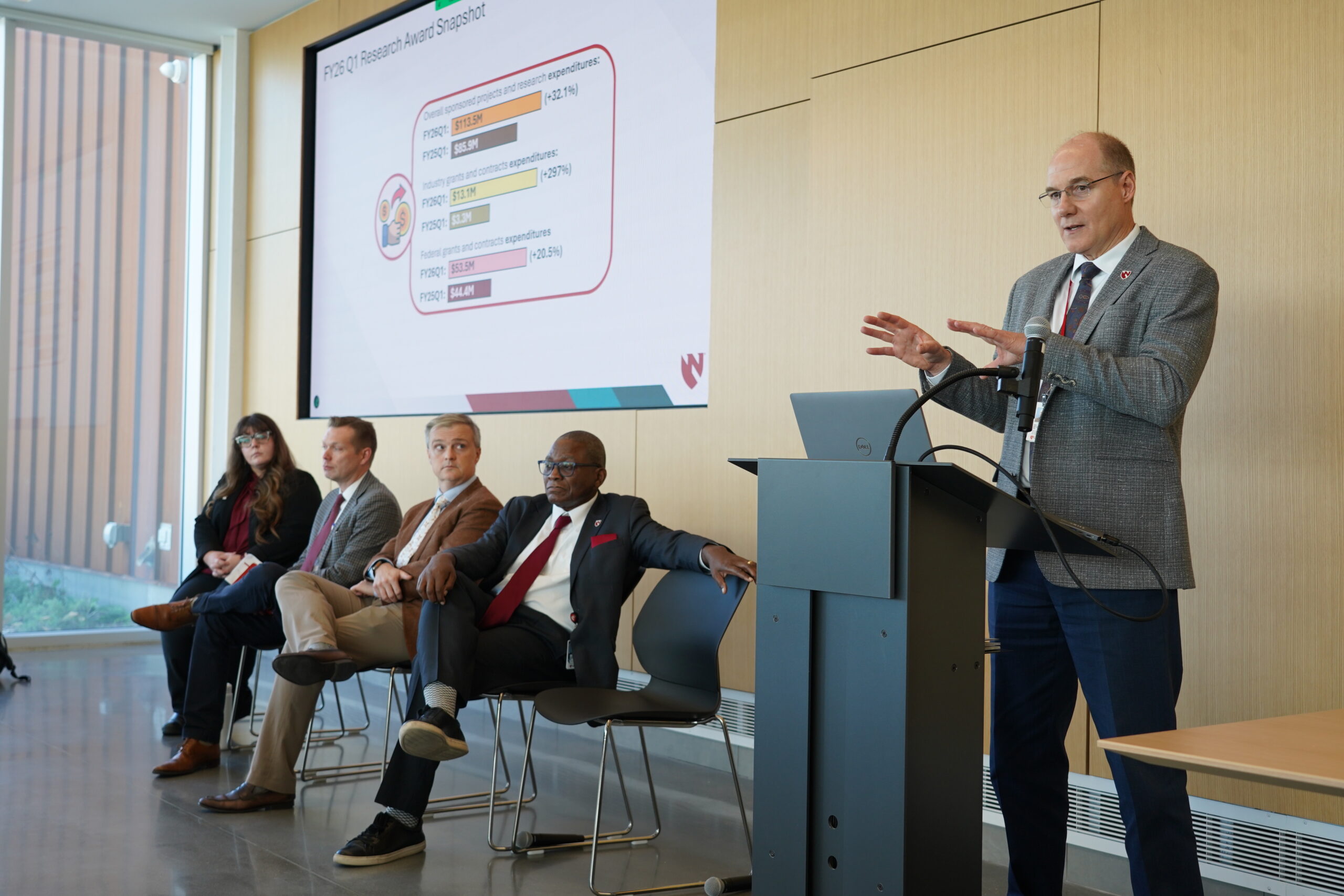Two years ago, as a University of Nebraska-Lincoln freshman, Sam Lockhart knew nothing about venture capital — let alone things like due diligence, term sheets or how to analyze a business plan. But at a College of Business recruitment event for student organizations, one caught his eye: The Husker Venture Fund (HVF).
Working with a fund of over $1 million, and typically making investments of around $25,000, the student-led group is a key player in Nebraska’s small VC scene. HVF trained Lockhart and let him work on deals. Now, he’s one of three managing directors steering the fund with about 30 other students.
“When you look at the Midwest compared to other areas across the country, there’s a lot less total VC investment here, and less access to capital for founders,” Lockhart said. “So it’s cool for our group to be able to be a part of that in Nebraska.”
College VC funds are uncommon — except maybe in Nebraska, which has two. Alongside the HVF, the University of Nebraska at Omaha has the Maverick Venture Fund (MVF). Meanwhile, a third fund is in development at Creighton University.
Since its founding in 2020, the HVF has invested over half a million dollars across 19 startups, nearly all of them based in Nebraska. The MVF, established in 2018, has made 15 investments worth roughly $275,000, also focused on Nebraska startups.
Each fund has a different setup. But they have similar challenges, ranging from keeping consistency with a revolving cast of students to maintaining the funding for impactful investments. In doing so, they aim to fill a gap in pre-seed funding while supporting the next generation of potential funders and founders.
“You get the VC education, you get the real world experience, and then you get to invest real dollars into real companies and make a difference for local founders,” said Alex Wewel, the assistant director at UNO’s Center for Innovation, Entrepreneurship & Franchising, which oversees the MVF.
What’s in a fund?
In 2020, Emily Kist was locked down in her apartment amid the COVID-19 pandemic. In the middle of her time at UNL, and reflecting on her VC internships at Nebraska Angels and Nelnet, Kist decided to create a campus group for VC.
“I hadn’t heard about anything on campus related to venture capital or startups,” Kist said. “I didn’t know any students who were studying it. No one my age really had been talking about it. So I was at a place where I was trying to find community on campus around this subject.”
But what would this group look like? At UNO, the Maverick Fund is part of a three-semester class, though it can also be taken without credits, and was originally meant for graduate students (now, undergraduates can also be involved). Other universities may have a group or class to educate students about VC, but no fund with which to make actual investments.
Together with Adam Folsom, another student interested in VC, Kist consulted with Nebraska entrepreneurs and interviewed other college VC programs. Their effort became the Husker Venture Fund, which is deliberately a student group.
“We decided not to make it a class, because that would have just slowed us down,” Kist said. “We wanted to get things up and moving … and to have flexibility for future leaders to change things.”
The HVF and MVF are structured in much the same way, though, with a revolving fund. Instead of having to pay investors back, any gains return to the students for future use. The HVF’s fund is through the University of Nebraska Foundation, while the MVF’s is supported by UNO’s Center for Innovation, Entrepreneurship & Franchising.
Experience and pipeline
For the Nebraska startup ecosystem, having more venture capital funds with the ability to make early investments is crucial for finding support. For the students involved in the MVF and HVF, the experience is all about education.
Both funds have an initial bootcamp-like training to get students up to speed on VC terms and ideas. After that, as they explore deals, question founders about their startups and write investment reports, students gain a sense of confidence with navigating the world of entrepreneurship.
“We’re college students — we’re not going to make every perfect deal,” said Adam Messman, an HVF managing director. “Just being able to gain some experience early on that a lot of other students don’t have at other universities” is a benefit.
While it can be challenging to have rotating leadership at a VC fund as new students arrive and others graduate, fund consistency comes as students train each other and rely on advisers from the entrepreneurship community.

Student funds are also a place for founders to hone their pitching skills. Taylor Korensky, the founder of Appsky, a software development startup, remembers how valuable his experience was when getting an investment from the MVF in 2020.
Getting to talk to those overseeing the fund gave “a view of understanding how investments are made … normally, that’s the closed door after you do your pitch,” Korensky said. “At any stage (for a startup), those types of checkpoints can be valuable, because it helps you stop and do the homework that you might not always want to do.”
Students have gone on to internships and careers in VC and to work at startups. Kist is proud that the HVF has also been an opportunity for women to step into a world that is traditionally dominated by men.
But there is also a kind of ecosystem dilemma: Student VC groups are creating a talent pipeline in Nebraska, but there are few VC jobs or internships here. “I often talked to people when starting HVF, saying, ‘There’s only two or three internship opportunities for students in the state,’ and everyone in the community was like, ‘Yeah, that’s a problem,’” said Kist, who now works as the venture and innovation associate at Nelnet.
“I think one of the hopes is that maybe students will graduate and either say, ‘I want to start a startup here,’ (or) ‘I want to continue to invest in Nebraska’s ecosystem — maybe start a fund,’” she said.
Creighton joins the fray
Over the next year, Nathan Preheim, the director of the Center for Enterprise Value at Creighton University, hopes to have a new $1 million student VC fund up and running. But his model will look a little different from what MVF and HVF do.
The fund will be part of a class aimed at investing in Creighton students and alumni. But rather than operating a revolving fund from donations, Preheim wants students to target a modest return to pay back to investors. And instead of focusing on just classic VC equity investments, he wants to be able to make investments in the form of debt.
“If I look at 100 startups on this campus, I would bet a very small percentage of those startups are going to be well suited for an equity investment that truly has high tech, high growth potential,” Preheim said. “They need a little bit of seed capital. Their goal is not to 10x their growth in three years. Their goal is not to sell … so debt will be a really good instrument for us.”
That means the curriculum will also look different. Each business, and each investment instrument, might need a different approach to due diligence, for example. And for Preheim, creating this VC fund goes hand in hand with fostering a more entrepreneurial environment at the university.
Some Creighton students, like junior Mary Margaret Mellen, are already excited for the new VC fund. As a nonprofit founder and investment banking intern, she sees the potential for how the fund can invest in students like Rian Jacobs.
Jacobs creates and sells her own biodegradable bobbers for fishing. “I would hope that as we look at investing, our thesis revolves not only around capable founders who are willing and wanting to learn, but also around businesses that are creating tangible impact,” Mellen said.
Risk of losing community support, impact
Whether operating off of donations in a revolving fund or aiming for investor returns, the basic economics of VC remain the same. These student funds need to be raising dollars, or else there won’t be any money to continue to invest while they wait years for returns.
Some Nebraska entrepreneurs worry that MVF is struggling with this. Founded in 2018, the fund once made $25,000-$50,000 investments. Now, its typical spend is closer to $10,000 — not a small amount, but much less impactful.
“Like everywhere else, it’s a little bit tough (to raise funds), especially right now,” said Wewel, who oversees the MVF, when asked by Silicon Prairie News about that concern. “But that’s not going to stop us from continuing programming … we are working with our foundation to obtain dollars, but we currently do have money to invest.”
The HVF is in a stronger position — for now. With over half of the current fund invested, students are already planning for how to raise more money. “Husker Venture Fund has a very healthy path forward,” said Maddock Oberzan, a managing director. “If we’re able to get additional donations, then we can expand either the size of investments or number of investments, as well as ensure the security of the fund.”
But Charlie Cuddy, managing partner at Move Venture Capital, and an adviser to both the HVF and MVF, is worried that support won’t keep up. He thinks there’s a tendency in Nebraska to fund good ideas, but not long enough to be successful. “What’s going to end up happening if we don’t fund it appropriately is we’re going to have two or three of their portfolio companies inevitably break out,” he said.
“It’s going to return a bunch of capital, but the thing’s not going to have existed for three or four years,” Cuddy said. “Everyone’s going to look around, wonder where (the successful startups) came from, and say, ‘Oh, we should fund that thing’ — and then we have to start over, because we didn’t fund (student VC) when it needed to be funded. We funded it when it was convenient.”
Lev Gringauz is a Report for America corps member who writes about corporate innovation and workforce development for Silicon Prairie News.



